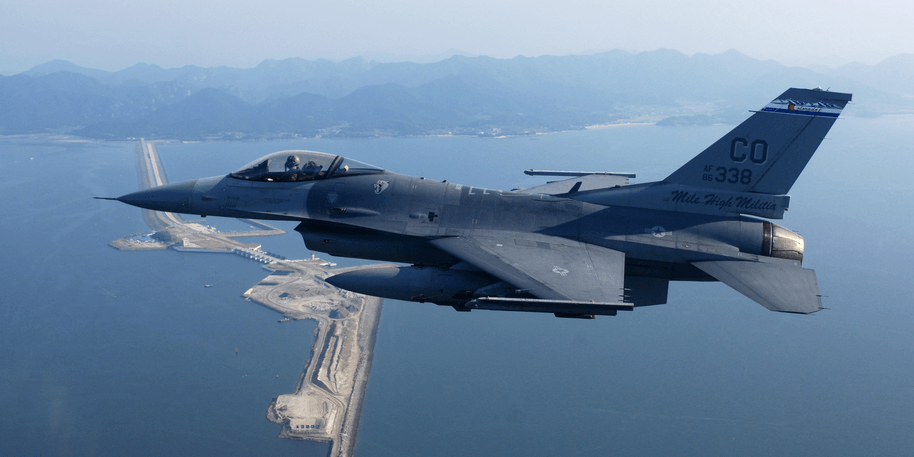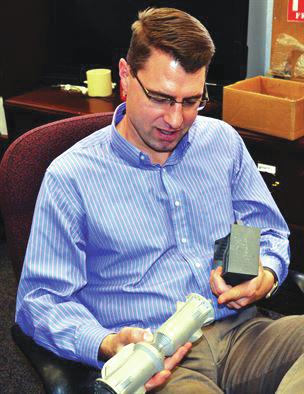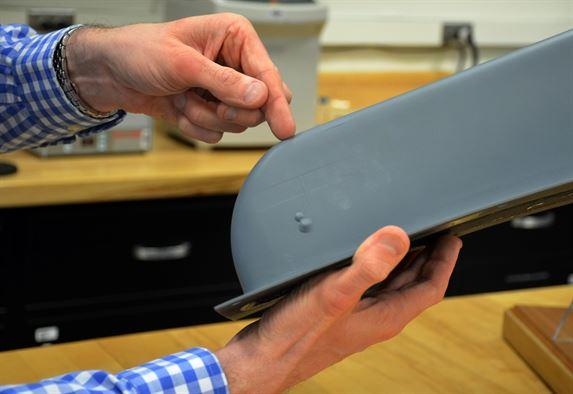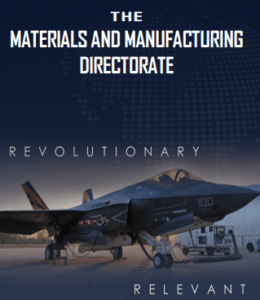Air Force Research Laboratory’s Materials and Manufacturing Directorate Continue to Explore the Benefits and Challenges of Additive Manufacturing
 I am an incredibly proud resident of Dayton, Ohio, born and raised in the Gem City. Not only did the Wright Brothers live and develop the first powered, heavier-than-air aircraft here (no, Kitty Hawk, just because your breezy beaches have better flying conditions does not mean it was invented there), it is also home of the state’s largest single-site employer, Wright Patterson Air Force Base. Scientists and engineers who work on base at the Air Force Research Laboratory (AFRL) are constantly researching and working with new and innovative technologies, like additive manufacturing. Last year, AFRL researchers were investigating 3D printed flexible hybrid electronics, and two Ohio congressmen announced $10 million in funding for the Additive Manufacturing Innovation Research Program.
I am an incredibly proud resident of Dayton, Ohio, born and raised in the Gem City. Not only did the Wright Brothers live and develop the first powered, heavier-than-air aircraft here (no, Kitty Hawk, just because your breezy beaches have better flying conditions does not mean it was invented there), it is also home of the state’s largest single-site employer, Wright Patterson Air Force Base. Scientists and engineers who work on base at the Air Force Research Laboratory (AFRL) are constantly researching and working with new and innovative technologies, like additive manufacturing. Last year, AFRL researchers were investigating 3D printed flexible hybrid electronics, and two Ohio congressmen announced $10 million in funding for the Additive Manufacturing Innovation Research Program.
According to its website, the AFRL’s Materials and Manufacturing Directorate works on “developing materials, processes, and advanced manufacturing technologies” for spacecraft, aircraft, rockets, and several ground-based systems. Other Air Force operating commands and product centers rely on the directorate’s work, materials expertise, and advanced manufacturing methods to help solve operational, system, and expeditionary deployment issues. Engineers and scientists with the directorate know that additive manufacturing can be a pretty powerful tool.
An article published on the AFRL site explains that the Air Force, and specifically scientists with the directorate, are continuing to explore additive manufacturing, evaluating its challenges and opportunities.
Dr. Jonathan Miller, a materials scientists and the additive manufacturing lead for the directorate, said, “Additive manufacturing is a huge opportunity for us. It allows us to manufacture unique form factors; it provides the opportunity to add functionality and capability to structures that already exist. Essentially, it allows us to redefine manufacturing.”
Machines became the norm for mass production during the Industrial Revolution; in order to produce a specific design, many of these manufacturing methods needed material to be molded or milled away from a bigger form. In contrast, additive manufacturing is achieved by layering materials, which enhances speed, increases design opportunities, and gives engineers another alternative for creating shapes that are much closer to what they actually need.
Dr. Miller explained, “The biggest problem with conventional manufacturing processes is time. Manufacturing is an iterative process, and you never get a part ‘just right’ on the first try. You spend time creating the tools to manufacture a complex part and then spend more time when you realized an initial design needs to be modified. Additive manufacturing offers lower cost tooling and lower lead times. The early mistakes don’t hurt you as badly.”
 Scientists who are working to make better metal products are now able to use more affordable equipment and varied processes to achieve their goals. As the technology evolved from just being a way to develop prototypes to an actual production method, the benefits of this new technology, and the myriad of applications for its use in the Air Force, grew exponentially. For one, it is much more manageable to maintain aircraft if you have access to custom parts and unique geometric shapes. Lightweight parts, engine components, and custom tools help “enable better maintenance and aircraft longevity.”
Scientists who are working to make better metal products are now able to use more affordable equipment and varied processes to achieve their goals. As the technology evolved from just being a way to develop prototypes to an actual production method, the benefits of this new technology, and the myriad of applications for its use in the Air Force, grew exponentially. For one, it is much more manageable to maintain aircraft if you have access to custom parts and unique geometric shapes. Lightweight parts, engine components, and custom tools help “enable better maintenance and aircraft longevity.”
“Additive manufacturing can address a multitude of challenges for us, and there is a big pull to implement these processes from the logistics community. The fleet is aging, and replacement parts for planes built 30 years ago often no longer exist. Rapid production of a small number of hard-to-find parts is extremely valuable,” said Dr. Miller.

Dr. Mark Benedict, a senior materials engineer and America Makes Chief Technology Adviser at the AFRL’s Materials and Manufacturing Directorate, discusses the potential for additive manufacturing of aircraft components in metal. [Photo: U.S. Air Force photo/ Marisa Alia-Novobilski]
The directorate is investigating how to use additive manufacturing to ’embed functionality into structure, such as by adding electronic circuitry or antennas on non-traditional surfaces.’ We know that it’s possible to 3D print working circuit boards, and this technology could be very useful for flexible devices like performance monitors and activity trackers. But even after years of development and research, AFRL researchers still need to address several additive manufacturing implementation challenges, so the Air Force can benefit from the technology to the fullest extent. Some of these challenges include reduced material performance, quality assurance methods, basic materials compatibility, and a lack of standardized production processes.
“Understanding the safety, reliability and durability of a part is critical for an aircraft,” said Dr. Berrigan, additive lead for functional materials for the directorate. “We know this for parts made through other processes, but we don’t know this yet for additive.”

Dr. Dan Berrigan points to an embedded antenna on an MQ-9 aircraft part made possible through functional applications of additive manufacturing. Flexible circuits, embedded antennas and sensors are just a few of the potential manufacturing capabilities his team is exploring using additive technology. [Photo: U.S. Air Force photo/ Marisa Alia-Novobilski]
Dr. Berrigan said, “The long-term vision is to have functional and structural additive manufacturing to work more cohesively from the start. Rethinking systems-level design to incorporate functionality such as electrical wiring, sensors or antennas is a potential that additive can help us address. When you build something by layer, why not introduce channels for sensors, cooling or other functions?”
Even if the work is not done yet, AFRL researchers agree that with more research over time, the Air Force can more fully implement additive processes, both today and in the future. If they don’t completely know the ins and outs of the manufacturing methods used with these vitally important aircraft, they’re not sending them up in the sky. Luckily, the countless innovations available through additive manufacturing provides almost “limitless opportunities to explore.”
Discuss in the AFRL forum at 3DPB.com.
[Source/Images: AFRL]
Subscribe to Our Email Newsletter
Stay up-to-date on all the latest news from the 3D printing industry and receive information and offers from third party vendors.
You May Also Like
Profiling a Construction 3D Printing Pioneer: US Army Corps of Engineers’ Megan Kreiger
The world of construction 3D printing is still so new that the true experts can probably be counted on two hands. Among them is Megan Kreiger, Portfolio Manager of Additive...
US Army Corps of Engineers Taps Lincoln Electric & Eaton for Largest 3D Printed US Civil Works Part
The Soo Locks sit on the US-Canadian border, enabling maritime travel between Lake Superior and Lake Huron, from which ships can reach the rest of the Great Lakes. Crafts carrying...
Construction 3D Printing CEO Reflects on Being Female in Construction
Natalie Wadley, CEO of ChangeMaker3D, could hear the words of her daughter sitting next to her resounding in her head. “Mum, MUM, you’ve won!” Wadley had just won the prestigious...
1Print to Commercialize 3D Printed Coastal Resilience Solutions
1Print, a company that specializes in deploying additive construction (AC) for infrastructure projects, has entered an agreement with the University of Miami (UM) to accelerate commercialization of the SEAHIVE shoreline...






























